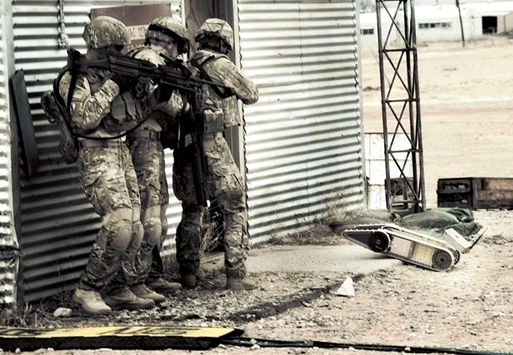
Robot scouting a building. (Image credit: iRobot Corp.)
Machines that can intelligently detect carried weapons and similar threats have the potential to save many lives in violence-prone urban areas. Security cameras could provide early warning of threatening people without needing a human perpetually paying close attention; an extremely dull job. Such a system could perhaps have spotted the Mumbai gunmen and automatically warned law enforcement. Military operations in urban terrain (MOUT) could also benefit from this capability on a scout robot platform such as iRobot’s SUGV, which is a small portable robot designed to scout ahead of infantry teams and help them spot threats. At present, using the robot distracts two people from the mission: the operator, whose situational awareness is compromised, and the person who consequently has to protect him. If the robot could autonomously spot threats then the operator could spend more time watching his surroundings and less time micromanaging the robot. He could also more quickly identify people as hostiles or noncombatants. Missions could proceed faster and be safer both for warfighters and for unarmed civilians in the area.

Robot scouting a building. (Image credit:
iRobot Corp.)
The AK-47 was selected as the class to spot because of its high prevalence-to-variability ratio.AK-47s are ubiquitous in the hands of people the US and NATO typically fight, but they are a restricted enough class with little enough variability that we can reasonably expect to achieve useful results in the project timeline. If time permits, the project may extend to RPG launchers as a second target, since AK-47s and RPGs have become the defining weapons of violent insurgencies.
The theoretical problem is how to detect the presence of a complex, slightly varied 3D object in an image with other unpredictable and varied content, when the target object may be rotated, scaled, or partially occluded. At Professor Torresani’s recommendation, the approach will be based on a Latent Support Vector Machine [1,2]. This approach uses deformable part models to identify variable 3D objects in different poses. It boasts a semiconvex or convex objective function, and spinoff techniques [3,4] which may be useful to speed training data preprocessing. Research to locate and evaluate additional methods will be performed.
The Caltech 256 dataset has an “AK-47” category with 98 images. (Download) Additionally, a brief web image search for “militants” or similar keywords reveals a multitude of suitable pictures.
Week 1 (4/12-19): Research & plan algorithm.
Week 2 (4/19-26): Preprocess data.
Week 3 (4/26-5/3): Code algorithm.
Week 4 (5/3-7): Preliminary results.
5/8: Milestone.
[1] Felzenszwalb, P.; McAllester, D.; Ramanan, D.; , "A discriminatively
trained, multiscale, deformable part model," Computer Vision and Pattern
Recognition, 2008. CVPR 2008. IEEE Conference on , vol., no., pp.1-8, 23-28 June
2008
[2] Felzenszwalb, P.F.; Girshick, R.B.; McAllester, D.; Ramanan, D.; , "Object
Detection with Discriminatively Trained Part-Based Models," Pattern Analysis and
Machine Intelligence, IEEE Transactions on , vol.32, no.9, pp.1627-1645, Sept.
2010
[3] Kumar, M.P.; Turki, H.; Preston, D.; Koller, D.; , "Learning specific-class
segmentation from diverse data," Computer Vision (ICCV), 2011 IEEE International
Conference on , vol., no., pp.1800-1807, 6-13 Nov. 2011
[4] Vijayanarasimhan, S.; Grauman, K.; , "Efficient region search for object
detection," Computer Vision and Pattern Recognition (CVPR), 2011 IEEE Conference
on , vol., no., pp.1401-1408, 20-25 June 2011